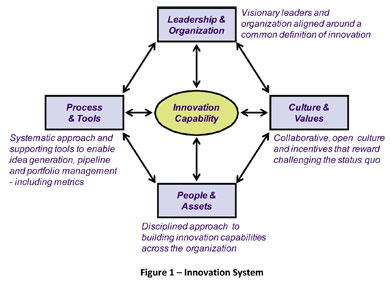

by George Chen
and Michel van Hove
In helping their clients (or themselves) to be more innovative, many consultants religiously copy the best practices of well-known innovators. However, these imitations rarely result in the same success because most clients and consultants simply "layer" the copied processes and tools onto existing infrastructure without addressing what's keeping them from being innovative in the first place. One would-be innovator summed up his dysfunctional approach to innovation rather succinctly–"I say innovation is my top priority, but I don't effectively allocate sufficient time, resources, or efforts for it to walk the innovation talk."
So before starting on a journey to identify and implement "leading" innovation practices, first review your entire business system and identify all the barriers that keep innovation from taking root in the first place. While the principles behind processes might be similar or even the same, a successful design depends on factors that are unique to your organization.
Think of this like a well-established computer hardware company delivering services for the first time. Metrics such as return on assets will be meaningless for this new business, yet the all the existing reporting and accounting systems were designed to track that metric. Metrics are important but need to be closely related to what you are expecting innovation to deliver–use of the wrong metrics leads to organizational behaviors that often inappropriately kill ideas rather than progress them.
To holistically assess your business system, look at four key components: leadership and organization, process and tools, people and assets, and culture and values. Figure 1 illustrates the concept:

These components must be thought of and designed systemically for any given organization, large or small. If you want to alter your "stage gate" process, to create and nurture new business opportunities that are both homogeneous and heterogeneous to your current business model, you can redesign the process to produce both types. But will your measures (both in process and outside of the stage gate process) accommodate? Or do you need to take another look at those measures as well? Furthermore, will you and your colleagues have enough time to assess substantially different opportunities or business models and concepts?
Commonly Observed Barriers
- Leadership and organization: Not walking the talk
- Process and tools: Too little or too restrictive
- Allow divergence and exploration at the front end;
- Synthesize individual ideas into bigger platforms before selecting specific ideas to develop further;
- Use experiments to test critical assumptions and refine the business model before locking it in; and
- Adjust evaluation criteria throughout the process to reflect the stage of development of the innovation.
- People and assets: Isolating innovation responsibility
- Culture and values: Fear of failure
Many mission statements list innovation as a core value. But when you focus only on daily sales, projects, current accounts, or other day-to-day matters, guess what you're really focusing on?
In many firms, employees are told to "go innovate," yet are not given the tools and resources needed to succeed. Other companies go to the other extreme, implementing rigorous processes that squeeze the life out of would-be innovations instead of nourishing good ideas into better ones. Are you repeating these mistakes?
Instead, good innovation processes share the following characteristics:
Management and partners often pay lip service to the need to harness innovation talent throughout their organizations, but in practice they restrict innovation to a few individuals or departments. Diversity matters. Bring everyone that you can into the process to elevate its effectiveness.
Far too often, companies minimize the importance of organizational culture when it comes to innovation. As one executive shared, "Real and continuing innovation comes about as a result of a deeply ingrained culture of innovation." Many companies suffer from a fundamental cultural flaw–fear of failure. These organizations do not consider failure to be an option and unsuccessful risk-takers are stigmatized. In contrast, Google exemplifies and reinforces the importance of innovation by letting employees spend 20 percent of their time working on their own ideas and keeping several active email lists to collect ideas from all employees. Most of these efforts may not result in successful products or services, but the ones that bubble to the top sure beat some tough competitors. So don't be afraid to fail! It is an important component of a superior ongoing innovation effort.
Overcoming the Barriers
As you identify the specific barriers to innovation, you will also identify remedies for overcoming them. When you do, remember:
- Don't just treat the symptoms. Identify the root causes for better remedies.
- Don't only act on one issue at a time. Think of a portfolio of tactics that builds a system that fosters innovation.
- Don't blindly copy best practices. Understand why they work and how they may fit your organization; then put these insights into practice.
On the Road to Success
If you want to sustain growth in the consulting industry, you have no choice: you have to be innovative. It takes time. There is no magic trick that can make innovation happen overnight. The good news is that many firms–in consulting and other industries–have succeeded in building innovation competence and excellence. These winners are clear as to why they are innovating, what areas they need to focus their innovation efforts on, and how they intend to approach it all. Conducting an innovation "diagnostic" and acting upon its results is one proven way to get started. Acting systemically on all of your innovation blockages will help you get the job finished and enable your business to leap forward.
George Chen is a Chicago-based director and Michel van Hove is an Amsterdam-based principal of Strategos, a global a strategy and innovation consulting firm and the Strategic Services division of Innovaro. Learn more about the authors, Strategos and Innovaro at www.strategos.com and www.innovaro.com.